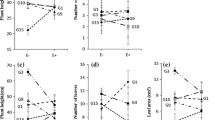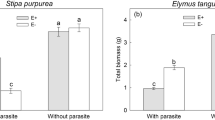Abstract
Neotyphodium endophytes are asexual, seed-borne fungal symbionts that are thought to interact mutualistically with their grass hosts. Benefits include increased growth, reproduction, and resistance to herbivores via endophytic alkaloids. Although these benefits are well established in infected introduced, agronomic grasses, little is known about the cost and benefits of endophyte infection in native grass populations. These populations exist as mosaics of uninfected and infected plants, with the latter often comprised of plants that vary widely in alkaloid content. We tested the costs and benefits of endophyte infections with varying alkaloids in the native grass Achnatherum robustum (sleepygrass). We conducted a 4-year field experiment, where herbivory and water availability were controlled and survival, growth, and reproduction of three maternal plant genotypes [uninfected plants (E−), infected plants with high levels of ergot alkaloids (E+A+), and infected plants with no alkaloids (E+A−)] were monitored over three growing seasons. Generally, E+A+ plants had reduced growth over the three growing seasons and lower seed production than E− or E+A− plants, suggesting a cost of alkaloid production. The reduction in vegetative biomass in E+A+ plants was most pronounced under supplemented water, contrary to the prediction that additional resources would offset the cost of alkaloid production. Also, E+A+ plants showed no advantage in growth, seed production, or reproductive effort under full herbivory relative to E− or E+A− grasses, contrary to the predictions of the defensive mutualism hypothesis. However, E+A+ plants had higher overwintering survival than E+A− plants in early plant ontogeny, suggesting that alkaloids associated with infection may protect against below ground herbivory or harsh winter conditions. Our results suggest that the mosaic of E−, E+A+, and E+A− plants observed in nature may result from varying biotic and abiotic selective factors that maintain the presence of uninfected plants and infected plants that vary in alkaloid production.




Similar content being viewed by others
References
Cheplick GP, Clay K (1988) Acquired chemical defenses in grasses: the role of fungal endophytes. Oikos 52:309–318
Cheplick GP, Faeth SH (2009) The ecology and evolution of the grass-endophyte symbiosis. Oxford University Press, Oxford
Clay K (1988) Fungal endophytes of grasses: a defensive mutualism between plants and fungi. Ecology 69:10–16
Clay K (1990) Fungal endophytes of grasses. Annu Rev Ecol System 21:275–297
Clay K (1998) Fungal endophyte infection and the population dynamics of grasses. In: Cheplick GP (ed) Population biology of grasses. Cambridge University Press, Cambridge, pp 255–285
Clay K, Schardl CL (2002) Evolutionary origins and ecological consequences of endophyte symbiosis with grasses. Am Nat 160:S99–S127
Clay K, Holah J, Rudgers JA (2005) Herbivores cause a rapid increase in hereditary symbiosis and alter plant community composition. Proc Nat Acad Sci 102:12465–12470
Faeth SH (2002) Are endophytic fungi defensive plant mutualists? Oikos 98:25–36
Faeth SH (2009) Asexual fungal symbionts alter reproductive allocation and herbivory over time in their native perennial grass hosts. Am Nat 173:554–565
Faeth SH, Bultman TL (2002) Endophytic fungi and interactions among host plants, herbivores, and natural enemies. In: Tscharntke T, Hawkins BA (eds) Multitrophic level interactions. Cambridge University Press, Cambridge, pp 89–123
Faeth SH, Sullivan TJ (2003) Mutualistic asexual endophytes in a native grass are usually parasitic. Am Nat 161:310–325
Faeth SH, Saikkonen K (2007) Variability is the nature of the endophyte–grass interaction. In: Popay AJ, Thorn ER (eds) Proc. 6th Internat. Symp. Fungal Endophytes of grasses. New Zealand Grassland Assoc, Dunedin, pp 37–48
Faeth SH, Shochat E (2010) Inherited microbial symbionts in a native grass increase herbivore abundances and alter diversity and community structure of arthropod communities. Ecology (in press)
Faeth SH, Helander ML, Saikkonen KT (2004) Asexual Neotyphodium endophytes in a native grass reduce competitive abilities. Ecol Lett 7:304–313
Faeth SH, Gardner DR, Hayes CJ, Jani A, Wittlinger SK, Jones TA (2006) Temporal and spatial variation in alkaloid levels in Achnatherum robustum, a native grass infected with the endophyte Neotyphodium. J Chem Ecol 32:307–324
Hamilton CE, Faeth SH, Dowling TE (2009) Distribution of hybrid fungal symbionts and environmental stress. Microb Ecol 58:408–413
Hartley SE, Gange AC (2009) Impacts of plant symbiotic fungi on insect herbivores: mutualism in a multitrophic context. Ann Rev Entomol 54:323–342
Hunt MG, Newman JA (2005) Reduced herbivore resistance from a novel grass–endophyte association. J Appl Ecol 42:762–769
Jani AJ, Faeth SH, Gardner D (2010) Asexual endophytes and associated alkaloids alter arthropod community structure and increase herbivore abundances on a native grass. Ecology Letters 13:106–117
Jones TA, Ralphs MH, Gardner DR, Chatterton NJ (2000) Cattle prefer endophyte-free robust needlegrass. J Range Manag 53:427–431
Kaiser WJ, Bruehl GW, Davitt CM, Klein RE (1996) Acremonium isolates from Stipa robusta. Mycol 88:539–547
Koh S, Hik DS (2007) Herbivory mediates grass–endophyte relationships. Ecology 88:2752–2757
Lehtonen P, Helander M, Saikkonen K (2005) Are endophyte-mediated effects on herbivores conditional on soil nutrients? Oecologia 142:38–45
Leuchtmann A, Schmidt D, Bush LP (2000) Different levels of protective alkaloids in grasses with stroma-forming and seed-transmitted Epichloë/Neotyphodium endophytes. J Chem Ecol 26:1025–1036
Marsh CD, Clawson AB (1929) Sleepy grass (Stipa vaseyi) as a stock-poisoning plant. USDA Tech Bull 114, Washington, DC
Moon CD, Craven KD, Leuchtmann A, Clement SL, Schardl CL (2004) Prevalence of interspecific hybrids amongst asexual fungal endophytes of grasses. Mol Ecol 13:1455–1467
Morse L, Day TA, Faeth SH (2007) Neotyphodium interactions with a wild grass are driven mainly by endophyte haplotype. Funct Ecol 21:813–822
Müller CB, Krauss J (2005) Symbiosis between grasses and asexual fungal endophytes. Curr Opin Plant Biol 8:450–456
Petroski RJ, Powell RG, Clay K (1992) Alkaloids of Stipa robusta (Sleepygrass) infected with an Acremonium endophyte. Nat Toxins 1:84–88
Reekie EG (1999) Resource allocation, tradeoffs, and reproductive effort in plants. In: Vuorisalo TM, Mutkainen PK (eds) Life history evolution in plants. Kluwer Acad, Boston, pp 173–193
Root RB (1996) Herbivore pressure on goldenrods (Solidago altissima): its variation and cumulative effects. Ecology 77:1074–1087
Saikkonen K, Faeth SH, Helander M, Sullivan TJ (1998) Fungal endophytes: a continuum of interactions with host plants. Ann Rev Ecol System 29:319–343
Saikkonen K, Helander M, Faeth SH, Schulthess F, Wilson D (1999) Endophyte–grass–herbivore interactions: the case of Neotyphodium endophytes in Arizona fescue populations. Oecologia 121:411–420
Saikkonen K, Lehtonen P, Helander M, Koricheva J, Faeth SH (2006) Model systems in ecology: dissecting the endophyte–grass literature. Trends Plant Sci 11:428–433
Schardl CL, Craven KD (2003) Interspecific hybridization in plant-associated fungi and oomycetes: a review. Mol Ecol 12:2861–2873
Schardl CL, Leuchtmann A, Spiering MJ (2004) Symbioses of grasses with seedborne fungal endophytes. Ann Rev Plant Biol 55:315–340
Siegel MR, Bush LP (1996) Defensive chemicals in grass–fungal endophyte associations. Rec Adv Phytochem 30:81–119
Siegel MR, Latch GCM, Bush LP, Fannin FF, Rowan DD, Tapper BA, Bacon CW, Johnson MC (1990) Fungal endophyte-infected grasses: alkaloid accumulation and aphid response. J Chem Ecol 6:3301–3315
Sullivan TJ, Faeth SH (2004) Gene flow in the endophyte Neotyphodium and implications for coevolution with Festuca arizonica. Mol Ecol 13:649–656
Tibbets TM, Faeth SH (1999) Neotyphodium endophytes in grasses: deterrents or promoters of herbivory by leaf-cutting ants? Oecologia 118:297–305
United States Department of Agriculture (1988) Range plant handbook. Dover, New York
Acknowledgments
We thank C. Bang, L. Beard, T. Bender, L. P. Bush, K. Chen, T. G. Faeth, M. R. Faeth, H. Gan, C. Hamilton, T. Hunt-Joshi, A. Jani, M. King, E. Manton, L. Morse, J. Navarro, S. Steele, M. Tseng, and S. Wittlinger for assistance in the lab and field. We thank Dr. Kris Haskins and the staff at The Arboretum of Flagstaff for their generous assistance and use of field facilities. This research was funded by NSF grants DEB 0128343, 0613551, and 0917741 to SHF.
Author information
Authors and Affiliations
Corresponding author
Rights and permissions
About this article
Cite this article
Faeth, S.H., Hayes, C.J. & Gardner, D.R. Asexual Endophytes in a Native Grass: Tradeoffs in Mortality, Growth, Reproduction, and Alkaloid Production. Microb Ecol 60, 496–504 (2010). https://doi.org/10.1007/s00248-010-9643-4
Received:
Accepted:
Published:
Issue Date:
DOI: https://doi.org/10.1007/s00248-010-9643-4




